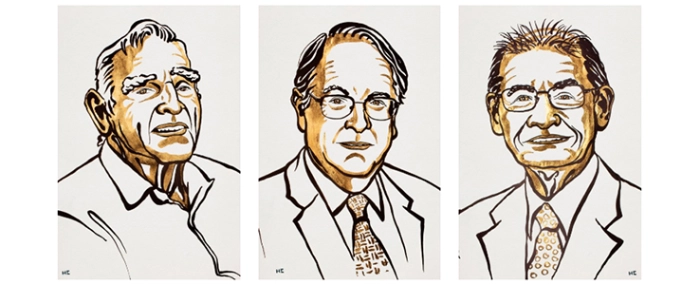
© Niklas Elmedhed - Nobel Media
General |
Nobel Prize to the creators of a rechargeable world
The Nobel Prize in Chemistry 2019 rewards the development of the lithium-ion battery. This lightweight, rechargeable and powerful battery is now used in everything from mobile phones to laptops and electric vehicles.
On my desk I have six items that would be utterly useless without the results of these gentlemen’s contributions. The development of the lithium-ion technology laid the foundation for a more mobile life and has very much aided us in becoming a more connected world.
As described in the press release announcing the Laureates, the foundation for the lithium-ion battery was laid during the oil crisis in the 1970s.
Back then, Stanley Whittingham was working on developing methods that could result in fossil fuel-free energy technologies. He started researching superconductors and discovered an extremely energy-rich material, which he then used to create an innovative cathode in a lithium battery. This was made from titanium disulphide which, at a molecular level, has spaces that can house – intercalate – lithium ions.
The battery’s anode was in part made from metallic lithium, which has a strong drive to release electrons. The result was a battery that literally had great potential, just over two volts. However, metallic lithium is reactive and the battery was too explosive to be viable.
John Goodenough predicted that the cathode would have even greater potential if it was made using a metal oxide instead of a metal sulphide. After a methodical search, in 1980 he was able to show that cobalt oxide with intercalated lithium ions can produce as much as four volts – which was an important breakthrough and would lead to much more powerful batteries.
With Goodenough’s cathode as a basis, Akira Yoshino went on to create the first commercially viable lithium-ion battery in 1985. But instead of using reactive lithium in the anode, he used petroleum coke, a carbon material that, like the cathode’s cobalt oxide, can intercalate lithium ions.
The result was a lightweight, hardwearing battery that could be charged hundreds of times before its performance deteriorated. The advantage of lithium-ion batteries is that they are not based upon chemical reactions that break down the electrodes, but upon lithium ions flowing back and forth between the anode and cathode.
"Lithium-ion batteries have revolutionised our lives since they first entered the market in 1991. They have laid the foundation of a wireless, fossil fuel-free society, and are of the greatest benefit to humankind," the Nobel Foundation, writes in the press release.
The three gentlemen have now been awarded the prize amount of SEK 9 million (about EUR 825'000), to be shared equally between the Laureates.
